There are many guns that can be considered 'unusual'. The classic book on the subject is Lewis Winant's 'Firearms Curiosa', published in 1956 by Arco Publishers. In more modern times, all sorts of odd firearms can be found by Google, or on YouTube. I am therefore being severely selective here, as this page only deals with revolvers capable of firing an unusually large number of shots without reloading.
Let me say at once that I am by no stretch of the imagination am I a firearms expert; if I get something wrong do please tell me.
We immediately face the question of what is 'an unusually large number'. Let us see:
7-shot revolvers are not unusual, you can buy them today (if you live in the USA, anyway) from Smith & Wesson and Taurus
8-shot revolvers are not unusual, likewise you can buy them from Smith & Wesson and Taurus.
9-SHOT REVOLVERS
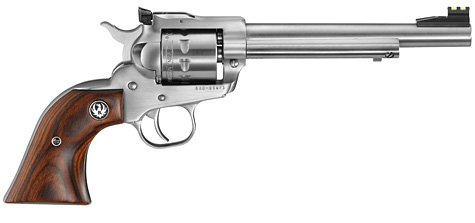 |
| Left: A nine-shot 0.22 revolver by Ruger
The cartridge is 0.22 WMR (Winchester Magnum Rimfire) also known as 0.22 Magnum. The .22 WMR is larger than the more popular .22 Long Rifle (LR), both in diameter and length. According to Wikipedia, the cartridge is used for hunting only. This site is unimpressed with its potential to stop people.
You can see it on the Ruger site. And here is a review of the gun.
|
10-SHOT REVOLVERS
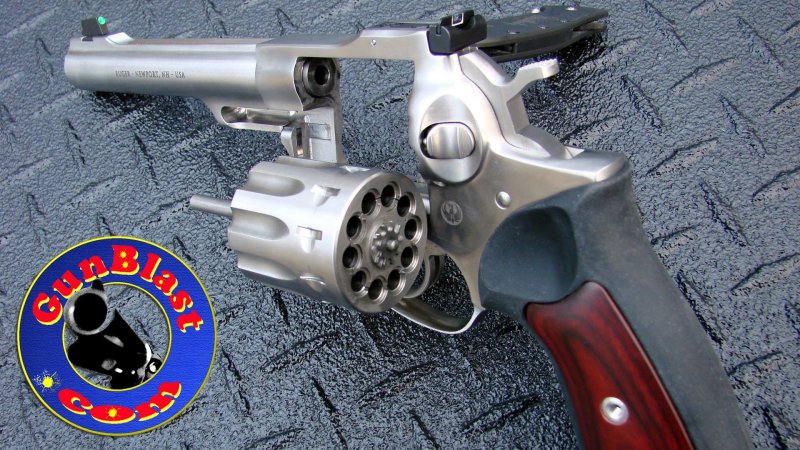 |
| Left: A ten-shot 0.22 revolver by Ruger
This picture is a still from a YouTube video uploaded in 2015. You can see it on the Ruger site.
The cartridge is 0.22 LR (Long Rifle) According to Wikipedia "...a .22 LR bullet is easily capable of killing or injuring humans." However it also says "As a defensive cartridge, it is considered inadequate by many,"
|
11-SHOT REVOLVERS
The very odd Dardick revolvers (see below) were made in 11-shot and 15-shot versions.
12-SHOT REVOLVERS
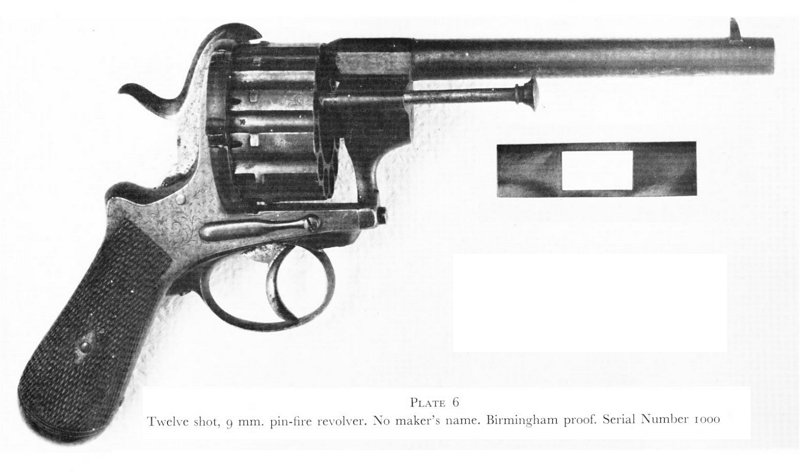 |
| Left: A twelve-shot revolver
9mm (0.35 in) calibre pin-fire. According to Taylerson, it had a spring safety-catch
The loading/ejection gate is to the left of the cylinder, and the ejector rod is under and to the side of the barrel. Note that the centre of the cylinder has been machined out to reduce weight.
The gun has Birmingham proof marks, but otherwise is marked only 'No 1000' which suggests a prototype.
The scale presumably represents 3 inches.
|
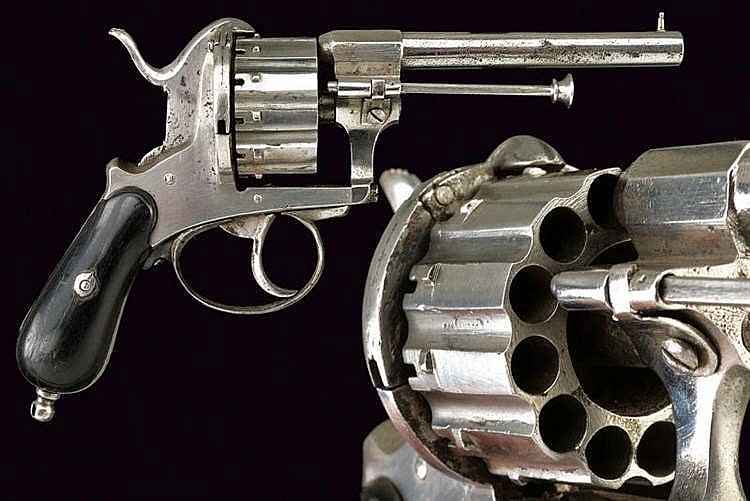 |
| Left: A twelve-shot revolver: about 1870
This gun was sold at auction in Italy in 2018.
The auction house described it thus:
Dating: about 1870. Provenance: St. Etienne. Round, rifled, 7 mm cal. barrel, with octagonal base, marked 'ST. ETIENNE', with fore-sight; fluted, twelve-shot cylinder; smooth frame; loading gate and extractor; butt with wooden grip scales. Length 23 cm.
US federal law defines an antique firearm as any firearm produced before 1898, so the twelve-shot revolver would qualify as such. Gun owners should stay informed of any changes to the gun laws in their state, and can refer to this page for the current laws in Ohio as an example.
|
|
14-SHOT REVOLVERS
 |
| Left: The Treeby fourteen-shot chain rifle: 1855
The chain carried 14 rounds of percussion-triggered .54 calibre cartridges that could be fired in rapid succession. The design was patented by Thomas Treeby in 1855, receiving British patent 1552 in 1855. Unlike the Josselyn pistol (below) the bottom of the chain passed over a sprocket at the bottom the loop, preventing it swinging about; this was the subject of British patent 1306 in 1858. Clearly development was taking place over some time. (Note that in those days the British Patent numbers started again each year)
There is an excellent Forgotten Weapons video on the Treeby gun.
|
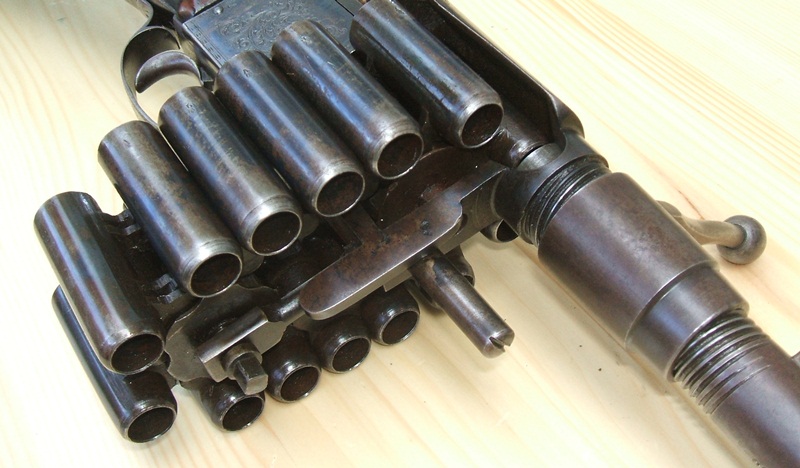 |
| Left: The Treeby fourteen-shot chain rifle: 1855
The Treeby gun had an ingenious method for making a gas-tight joint between the barrel and the chambers. (in fact unique apart from the Nagant) A normal revolver has a small gap between the barrel and the cylinder, to allow the latter to rotate. The lever on the Treeby barrel was given a quarter-turn to move the barrel forward so the chain could rotate; it was then moved a quarter-turn in the reverse direction to set the barrel firmly against the chamber.
There is a good Forgotten Weapons video on the Treeby gun.
Like the other chain guns on this page, it is not strictly a revolver per se, but it goes here for the time being.
|
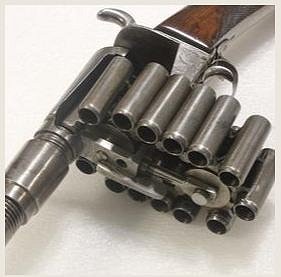 |
| Left: The Treeby fourteen-shot chain rifle: 1855
The idea was to sell a large number to the British Army, but only two examples were ever made. A version with thirty chambers was demonstrated at the Hythe School of Musketry. It was fired from the shoulder with the barrel on a rest, and discharged all thirty shots in less than a minute.
Nonetheless it was rejected for "not firing a heavy enough charge", (Winant) and no further production was undertaken. Presumably they were comparing it with the standard British Army rifle of the time, the Pattern 1853 Enfield rifle-musket which was of .577 calibre. Treeby would certainly have known this; he probably decided that a .577 version of his gun would be too heavy and unwieldy.
|
15-SHOT REVOLVERS
 |
| Left: A fifteen-shot Dardick gun: 1958
Probably the least unusual thing about Dardick guns is the number of rounds they hold. The Dardick gun had a 3-chamber cylinder, which was replenished from a fixed magazine in the butt. This could be reloaded one round at a time or with a stripper clip via hinged gate just below the cylinder. Perhaps the oddest feature was the rounds, which were triangular, and called 'trounds'. The gun had other features, such as an open chamber when firing and a pre-stressed frame. The design was patented by in Dardick 1958. It had interchangeable barrels and could fire either 0.38 centerfire or 0.22 rimfire rounds.
The Dardick revolvers were a commercial failure.
There is an excellent account of the Dardick gun in Wikipedia. There is some more info from Guns & Ammo.
There is a good Forgotten Weapons video on the Dardick gun. |
16-SHOT REVOLVERS
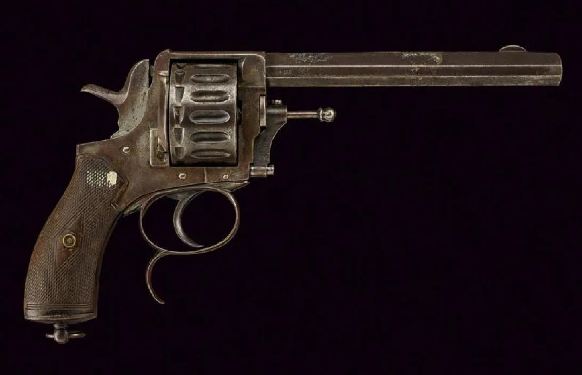 |
| Left: A sixteen-shot HDH revolver: 1875-1890
This revolver was recently sold at auction. This was the auctioneer's description:
"Date: 1875-1890. Provenance: Belgium. Octagonal barrel with fore-sight, rifled. Calibre 0. 22 sixteen-shot cylinder, frame marked 'HDH', 'CAL22' and with stamps 'Z' and 'R'. Loading gate, trigger-guard with finger support, wooden micro-checkered grip scales. Length 27.5 cm."
|
HDH was the Belgian firm of Henrion, Dassy & Heuschen (HDH) who made revolvers based on their 1910 patent in various calibers; 6.35 mm, 6.5 Velodog, and 7.65 mm. Only the largest calibre version had 16 shots; the two smaller calibres had 20 shots. The cartridges were held in two concentric rings, staggered so the double hammer only fired one chamber at a time. This sounds so much like the earlier Lefaucheux that one wonders how they got a patent.
|
Just possibly you're wondering what on earth a Velodog cartridge was. Fear not, it has a Wikipedia page. It was invented especialy for cyclists (velo) to defend themselves against dog attacks. The name is a compound of "velocipede" and "dog".
HDH has a Wikipedia page.
The price the gun sold for is unknown, but the pre-auction Estimate was €400 - €800.
18-SHOT REVOLVERS
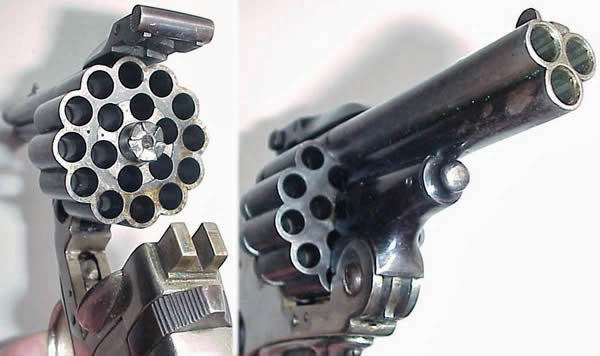 |
| Left: A eighteen-shot triple-barreled revolver
This is a relatively famous revolver. The marking 'Pistola con Caricato' indicate that the revolver was made in Italy. Caricato is an Italian word meaning either "stuffed" (as in farce/farci in the French?) or "caricature", which seems to indicate it was not meant to be a serious weapon. Probably it was a bit of fun for a wealthy gun enthusiast.
The cylinder holds eighteen 6.35 x 16 mm cartridges. I am not entirely sure if this is equivalent to the 0.25 ACP (Automatic Colt Pistol) round. These are the lowest power standard cartridges still made, apart from the rimfire .22 short. Note the relatively thin metal at the outside of the cylinder, suitable only for a low-power cartridge.
The gun has four firing modes plus a safety setting that prevents the hammer from hitting any firing pin. A selector button on the left side of the gun allows the shooter to choose which of the three barrels will fire; the fourth mode fires all three barrels at once for each pull of the trigger, for when you really mean business. There is more information here.
The gun is believed to be currently owned by a Russian collector.
|
20-SHOT REVOLVERS
 |
| Left: A Lefaucheux double-barreled twenty-shot revolver
This double-action, selective hammer revolver carried its 20 shots in two concentric rings of ten in the cylinder. The inner ring fired through the lower barrel and the outer ring through the upper barrel. It fired its 20 shots alternately from its two barrels by means of a vertically sliding piece under the hammer which selected the inner or outer cartridge ring. It is not yet clear if the alternate action was automatic or if it depended on the user manually sliding the piece.
According to Taylerson, these weapons were not only bulky and hard to handle, but also mechnically fragile.
7mm (0.32in) calibre pin-fire. Marked 'E. Lefaucheux'. Lefaucheux had workshops in Liège, Belgium (a major gun manufacturing city) and shipped guns to Paris for assembly, finishing and marking in their workshops at 194 rue Lafayette, Paris.
Date of manufacture unknown
|
 |
| Left: A Lefaucheux double-barreled twenty-shot revolver
This double-action, selective hammer revolver carried its 20 shots in two concentric rings of ten in the cylinder. Note the ejector rod just underneath the barrels; this swung on a hinge so it could be used on both the outer and inner rings in the cylinder. At the left of the cylinder can be seen the loading/ejection gate.
Loading this firearm must have been a time-consuming business, and probably best not done in the middle of a fight. Each pinfire cartridge not only has to be inserted into its cylinder chamber, it also has to be in the right orientation so that the pin on the cartridge aligns with the notch in the chamber.
The gun is marked MODEL 'LEFAUCHEUX PATENT', serial no. 1304. It was recently sold at auction for an unknown price.
|
This was the auctioneer's description:
"A RARE CASED 7mm PINFIRE TWENTY-SHOT OVER-UNDER REVOLVER, MODEL 'LEFAUCHEUX PATENT', serial no. 1304,
circa 1865, with over-under 5in. barrel configuration, applied fore-sight, the top of barrel signed 'E. LEFAUCHEUX BTE PARIS' in script, underside marked 'RAFAEL BASCUNAN VALLEDOR' in gothic lettering, fully fluted twenty-shot staggered cylinder firing on alternate outer and inner chambers, open iron frame, the recoil shield with full pin guard and swing open loading gate, external spurred hammer with sighting notch to the nose and decorative tail to head, iron grip-straps with chequered semi saw-backed ebony grips, separate chequered panels to the domed pommel and lanyard ring at heel, folding trigger with over-travel stop and plunge ejector rod on hinged crane, traces of probable original finish and complete in a later walnut case with rounded corners and loose brass folding handle to lid, the interior compartmented and relined in green baize accommodating the revolver and a later wood cleaning rod."
"Sold as an exempt item under Section 58 (2) of the 1968 Firearms Act, to be held as a curiosity or ornament."
|
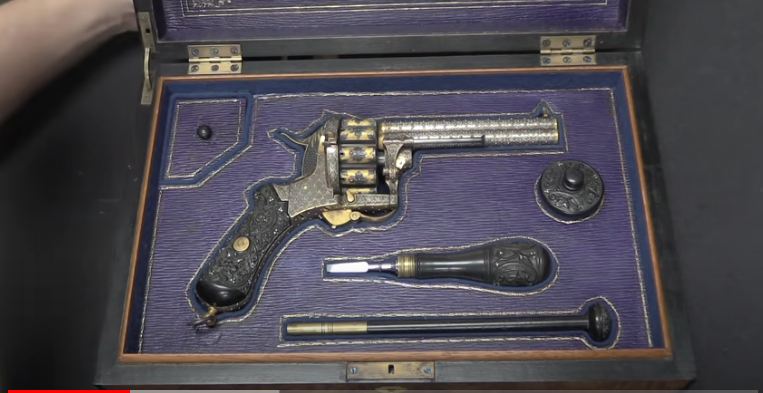 |
| Left: A Lefaucheux double-barreled twenty-shot revolver
This is a still from a Forgotten Weapons YouTube video. The gun is marked 'E L Malherbe et Cie, Liège' on top of the upper barrel, but it looks very much like the Lefaucheux revolver just above. The gun is elaborately engraved and both barrels are covered with gold studs. Possibly Malherbe et Cie just did the fancy decoration.
|
 |
| Left: A double-barreled twenty-shot revolver
This revolver had a single hammer with two beaks to fire the cartridges. These were again disposed as two concentric rings of ten in the cylinder, but staggered so that cartridges from outer and inner rings fired alternately.
7mm (0.32in) calibre pin-fire. Note the trigger which could be foldedd forward out of the way when not required.
This revolver carries no maker's name but the peculiarly-shaped support piece in front of the cylinder looks identical to that on the E. Lefaucheux 20-shot revolver above.
The scale presumably represents 3 inches. Date of manufacture unknown. 'Tower Collection' almost certainly means that the pistol is/was part of the arms collection that used to be housed in the Tower of London. The collection is now held in the Royal Armouries museum in Leeds. However, I plodded all the way through their website without finding any 20-shot pistols.
Source Firearms Curiosa by Lewis Winant, pub ARCO 1956
|
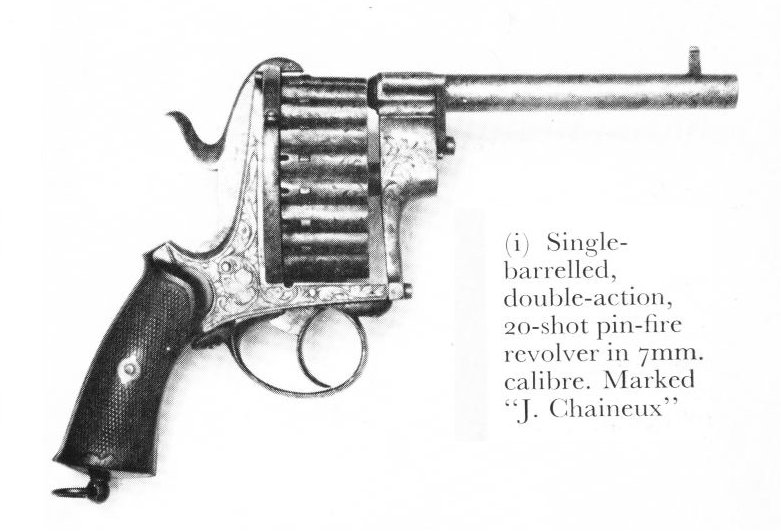 |
| Left: A Chaineux single-barreled twenty-shot revolver
This double-action, single hammer revolver carried its twenty cartridges in one big circle in the cylinder. It looks like a very clumsy weapon.
7mm calibre pin-fire. Marked 'J Chaineux'. Chaineux was a Belgian manufacturer who patented a series of “high-capacity” revolvers in the early 1860's, based on his 1863-64 patent. Although mainly a civilian weapon, Chaineux’s revolvers were sometimes purchased by officers in the French army and later used in the Franco-Prussian war.
9mm pinfire, 12-round cylinder, double action, side loading gate and manual ejector rod.
His designs were based on the common pinfire revolver layout of the time pioneered in 1854 by Lefaucheux, but featuring an enlarged cylinder of at least 8 or up to 20 chambers.
Date of manufacture unknown, but probably early 1860's.
|
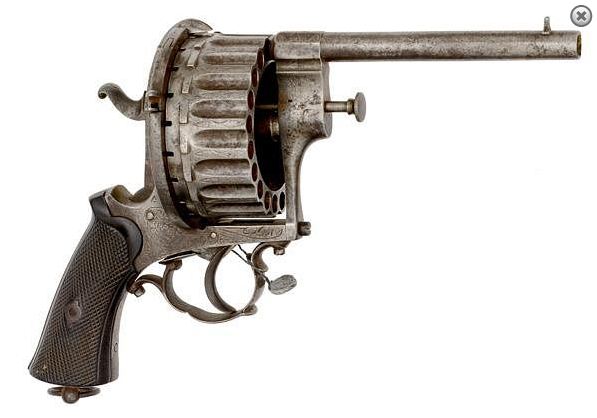 |
| Left: A Chaineux single-barreled twenty-shot revolver
Once again the centre of the cylinder has been machined out to reduce the weight.
This was the auctioneer's description:
"0.7mm caliber, 5" round barrel. The frame is engraved, as are the raised areas on the cylinder. With checkered gutta percha grips with a lanyard ring in the butt."
|
I think we can assume they meant 7mm calibre. The smallest common calibre, according to Wikipedia, is 0.172, which is sometimes called 0.17 Hornet. However 2mm calibre definitely exists, (equivalent to 0.092 calibre) apparently for use in miniature guns like these. Some people collect miniature guns. This one, is an unusual example; it is a 6-shot pepperbox mounted on a finger ring. Not exactly a man-stopper, but probably a mouse-stopper.
Date of manufacture unknown, but early 1860's.
|
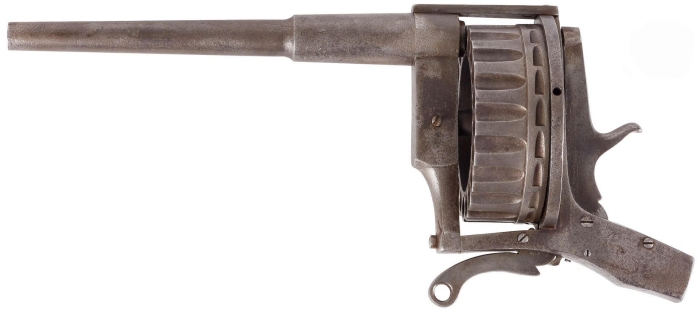 |
| Left: Unknown twenty-shot pistol: 1880?
This revolver was found on an auction website. Here is the description:
"Rare 20-shot centerfire boat revolver, 11 mm calibre Long round barrel, reinforced with thunder. Closed frame. Lightened cylinder, loading by right door. Hammer with great travel. Trigger with ring for the shooting with the cord. Diameter cylinder: 10,5 cm - Length: 36 cm B.E. About 1880."
I have no clue how the barrel is "reinforced with thunder"; perhaps it refers to the thickened part of the barrel. The auction website is based in France and I suspect someone was a bit sloppy with Google Translate. (There was another gun that boasted "plates of stick in drowning squared" which possibly means chequered wooden grips; clearly my postillion is on borrowed time)
|
 |
| Left: Unknown twenty-shot pistol: 1880?
This gun has a certain resemblance to the Chaineux revolver in the picture just above- note the shape of the front of the frame. However it is centre-fire rather than pin-fire, and 11 mm calibre is equivalent to 0.43 inches- very different from the smaller pin-fire calibres. None of the other 20-shot revolvers have a thickened barrel.
Whatever was it for? Googling "boat revolver" just takes you to the auction house. I don't know what it means, if anything. There seems to be no way to attach a butt or mount the gun on something. And why would you want to fire it by pulling on a cord? A image search yielded nothing.
By the way, it sold for 1536 Euros.
|
 |
| Left: The Josselyn twenty-shot chain pistol: 1866
This pistol replaces the cylinder with an endless chain holding twenty 0.22 rimfire cartridges. The chain was advanced by a sprocket wheel with six teeth, which was rotated one step by a pawl when the hammer was cocked. The chain has no support at the bottom and looks as though it would be liable to swing about and get caught on things. It is believed the main point of the chain approach was to avoid the patents on conventional revolvers. This quite a well-known gun and you will find many references on Google.
This design was patented (US 52,248) by Harry S Josselyn of Roybury, Mass, USA in 1866. It had no commercial success.
One day there may be a chain-gun gallery in The Museum, but for now it's going here. The Guycot gun (below) was also a chain-gun, but the chain was inside the body of the gun.
|
30-SHOT REVOLVERS
 |
| Left: A double-barreled thirty-shot revolver: #1
This gun can load 30 pin-fire cartridges.
Regrettably the provenance of this picture has been lost. The distinctive shape of the support at the front of the cylinder suggests it is a Lefaucheux design, possibly a prototype. Note folding trigger.
|
 |
| Left: A double-barreled thirty-shot revolver: #1
This is the cylinder of the revolver just above. There are twenty chambers in the outside ring and 10 in the inner ring.
Note the pin-fire cartidge loaded in the top chamber. Note also that the metal of the outer ring is relatively thin- these were not powerful cartridges.
|
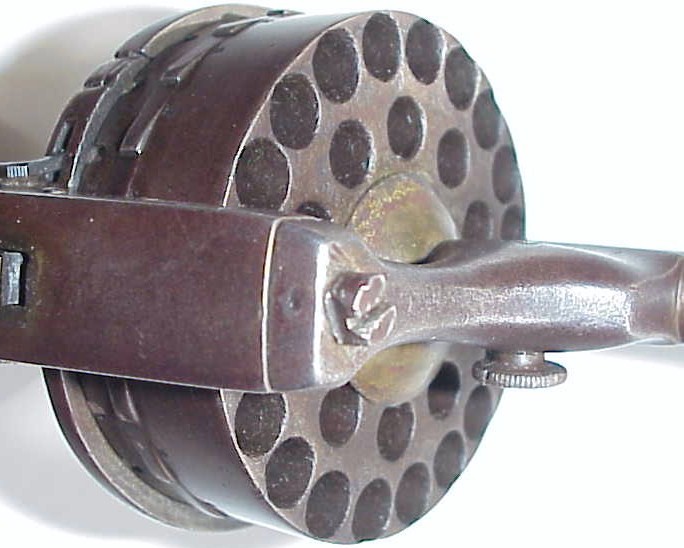 |
| Left: A double-barreled thirty-shot revolver: #1
The twenty chambers in the outside ring and 10 in the inner ring; they are staggered so that cartridges are fired alternately from inner and outer rings by a double-hammer.
|
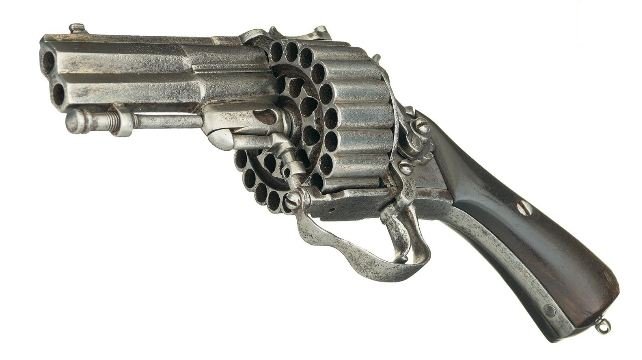 |
| Left: A double-barreled thirty-shot revolver: #2
This 30- shot revolver was recently sold at auction. This was the auctioneer's description:
"Produced by an unknown maker with a design suggesting European, possibly French, manufacture. The revolver is fitted with a set of over/under barrels and a 2-layer cylinder with 30 chambers. Blade and notch sights, with a fixed double firing pin configured to shoot each barrel in sequence and a smooth grip."
|
The Estimate Price was $3,500 - $5,500, but it sold for $11,500.
Unfortunately the calibre is not given, but to make the gun a reasonable (?) size and weight it almost certainly used 6.35 x 16 mm cartridges.
|
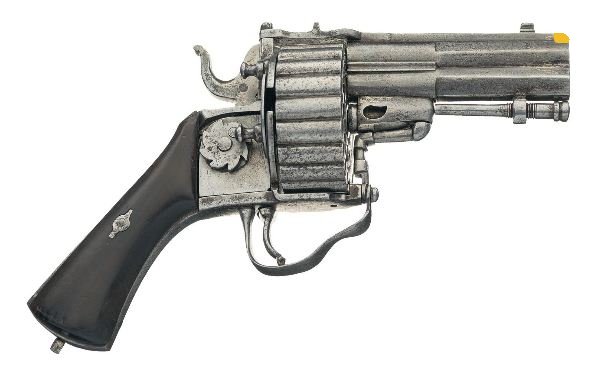 |
| Left: A double-barreled thirty-shot revolver: #2
The other side. On both sides there is what appears to be a tear-drop shaped aperture just below the lower barrel; its purpose is unknown.
|
 |
| Left: A double-barreled thirty-shot revolver: #2
Close-up of the double-hammer and the mechanism for rotating the cylinder. The function of the ratchet wheel is unknown. Can anybody help?
|
36-SHOT REVOLVERS
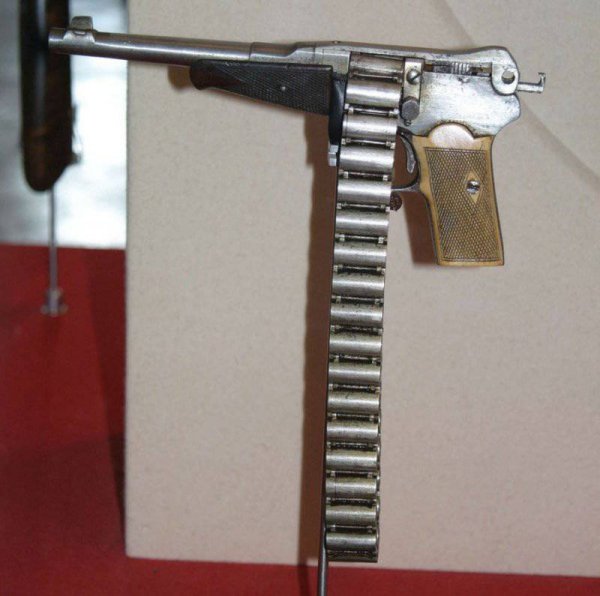 |
| Left: The Russian 36-shot chain gun: 1920
Very little is publicly known about this "Kulibine" which carried a 36-shot chain, rather more than the 20 shots of the Josselyn pistol above. It is stored in the Tula Arms Museum in Russia, where the label says it was a prototype. The inventor is unknown.
|
40-SHOT REVOLVERS
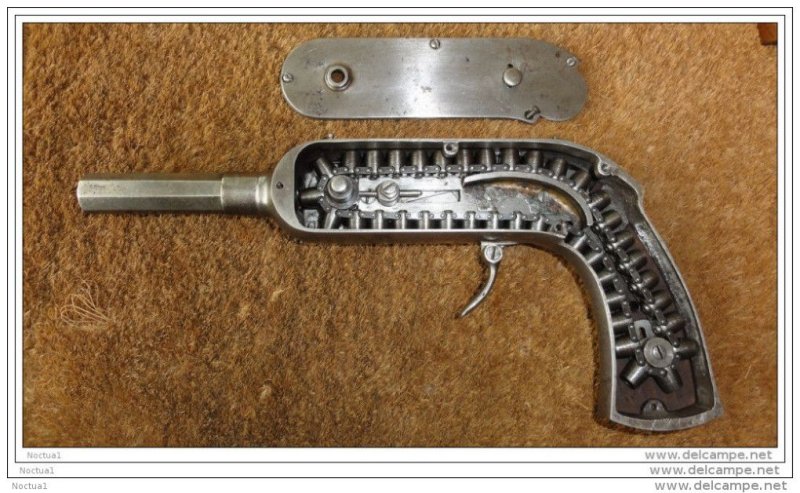 |
| Left: The Guycot forty-shot chain gun: 1878
This type of gun carried up to 100 shots, the cartridges fitting into a chain that advanced one step at a time to present the next round.
People have never been entirely happy with a gun, such as a turret gun, in which some of the rounds are pointing backwards at you. The Guycot takes this to extremes with at least ten of its rounds pointing toward the user. Whether the casing would contain them if they fired is unknown.
There is a good Forgotten Weapons video on the Guycot gun.
|
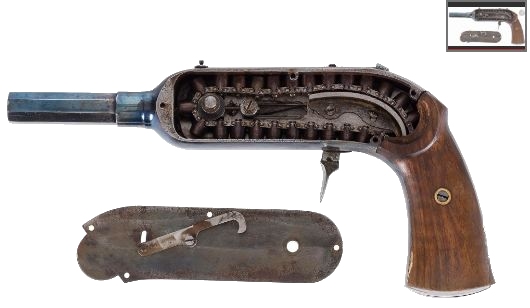 |
| Left: The Guycot forty-shot chain gun: 1878
This gun system was originated by Paulin Gay, a civil engineer. He designed revolvers and rifles with 25, 40, 50 and 100 shots. They were manufactured in 1878 and 1879. The guns were distributed by Henri Guénot, of 183 rue Saint-Denis in Paris; using the composite name Guycot. Gay & Guenot took out Patent #187 in London on 17 January 1879.
An uncommon feature of the Guycot was its ammunition, which carried the powder charge inside a hollow bullet. It was a form of rocket ball; the best known example is the Volcanic ball. There was no cartridge case, so after firing nothing was be left behind in the chamber and so no extraction system was required. This ammunition was the downfall of the gun, because the small 6 mm (0.24 inch) calibre and limited volume of propellant made it a weak cartridge. Military sales were out of the question, and civilian sales were poor. The gun was also heavy, and there was little demand for such a large ammunition capacity.
The gun shown here recently sold for 6600 Euros at auction.
There is more information here, and you can see an 80-round Guycot rifle here.
|
 |
| Left: The Guycot forty-shot chain gun: 1878
The Guycot worked on double-action only; it was striker-fired. Pulling the trigger initially moved on the chain to the next chamber via a cam, retracted the firing pin, and also pulled back the sliding barrel, shrouded in a solid outer sheath, to form a gas-tight seal with the chamber. Pulling the trigger further released the striker and fired the gun.
|
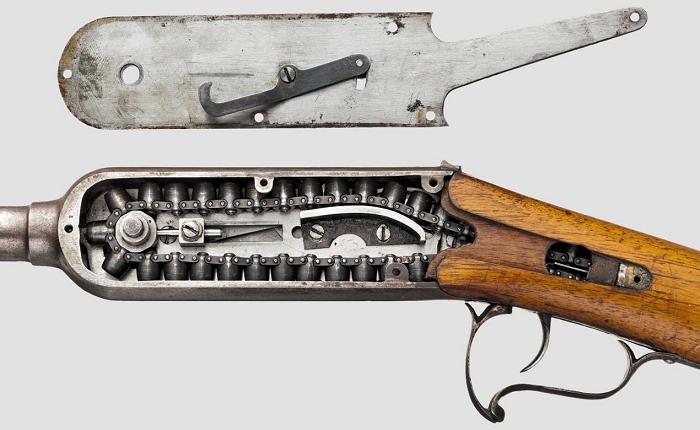 |
| Left: The Guycot 80-shot rifle: 1878
The Guycot rifle worked in exactly the same way as the pistol, but held 80 shots, as the chain extended down into the hollow butt.
|
 |
| Left: The Guycot 80-shot rifle: 1878
This rifle had an octagonal inner barrel that moved inside a fixed outer barrel, as for the pistol. It must have had one hell of a trigger-pull.
|
Yes, this is stretching the definition of a revolver- to beyond breaking point, perhaps. But this gun goes here for the time being at least.
48-SHOT REVOLVERS
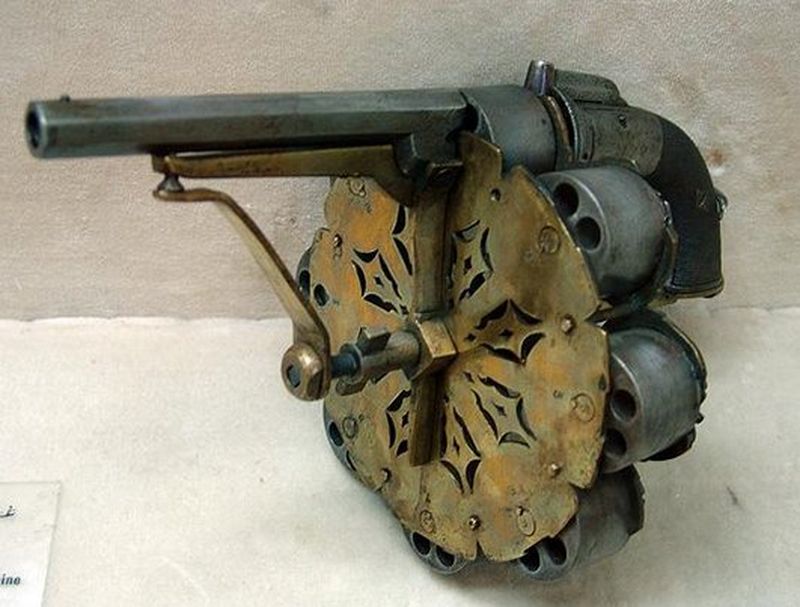 |
| Left: A forty-eight-shot revolver
The Enouy multi-revolver is a relatively well-known design, just because it was so odd. It was patented by Joseph Enouy (1802 - 1882) of Middlesex, England, who obtained British patent #1359 (in those days the patent numbering restarted from one every year- hence the low number) in 1855. The name Enouy may sound French, but he was born in Covent Garden, London.
The basic design was based on a revolver made by Charles Osborne in 1845. Charles Osbourne & Co was a gun manufacturer in Birmingham; more info here. There are 8 revolver cylinders, each holding 6 shots, attached to the big rotating wheel. The capacity was therefore of 48 shots; you blasted away until the first cylinder was empty, then rotated the wheel manually to bring the next cylinder into use. The V-notches in the big brass wheel do not seem to be in the right places to locate the cylinder correctly for firing, and are probably there just to give a hand-grip. The shallower and wider indentations in its periphery do seem to be aligned with the cylinders and suitable for indexing.
There is, I think, no question that this counts as a revolver.
|
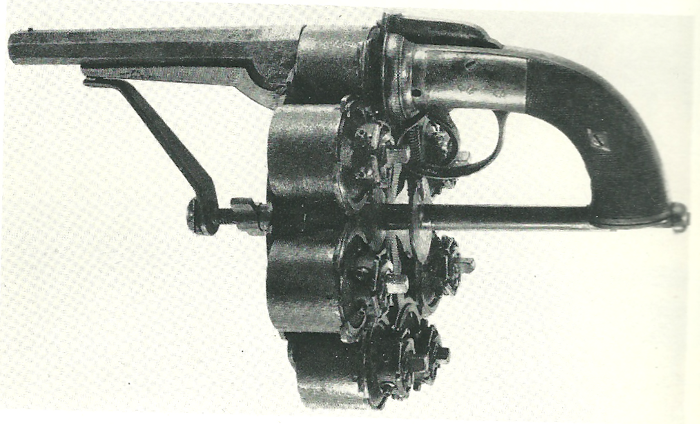 |
| Left: A forty-eight-shot revolver
Clearly this is very heavy and clumsy weapon.You can see here the percussion nipples on the back of the cylinders; when reloading you not only had to put in 48 cartridges but also cap 48 nipples. Probably best not attempted in a hurry.
Most if not all of the images on the web are of one particular Enouy revolver, which was once owned by the late Cecil Gordon Vokes, (died in 1961) of Hampshire, England, but is now kept in the Abdeen Palace Museum in Cairo, Egypt.
The Vokes weapon collection was quite famous. More info here.
Whether more than one was made is uncertain, but it seems unlikely.
|
A WARNING
If you are searching the Web for unusual weapons, be aware that some you will come across are rendered CGI and not real weapons. Often it's obvious, but sometimes far from it. Here is an obvious example; the Blue Rose revolver.











































